When it comes to scuba diving, whether you’re a wide-eyed beginner or a seasoned professional, there is something for everyone in Greece!
With its 13,676-kilometer coastline and an archipelago of around 6,000 islands (227 inhabited), Greece has an astonishing variety of scuba diving on offer, from big wall drop-offs and deepwater caves, to ancient wrecks and coral reefs.
It may be unsurprising to learn that before 2005, scuba diving in Greece faced severe restrictions. A seafaring nation with a long and rich maritime past, the high concentrations of antiquities and historic wrecks forced the authorities, fearing sites would be looted, to impose a near blanket ban on scuba diving at many areas around the mainland and islands.
Following a review by the European Union, which felt the restrictions hindered tourism, the Greek government gradually modified the rules and lifted many of the restrictions, opening the door to the burgeoning world of dive tourism.
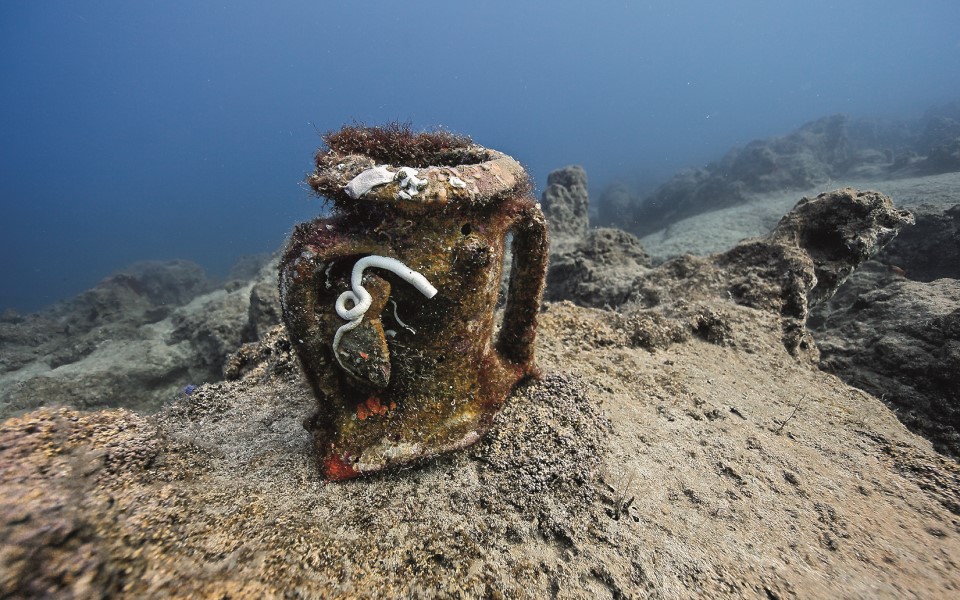
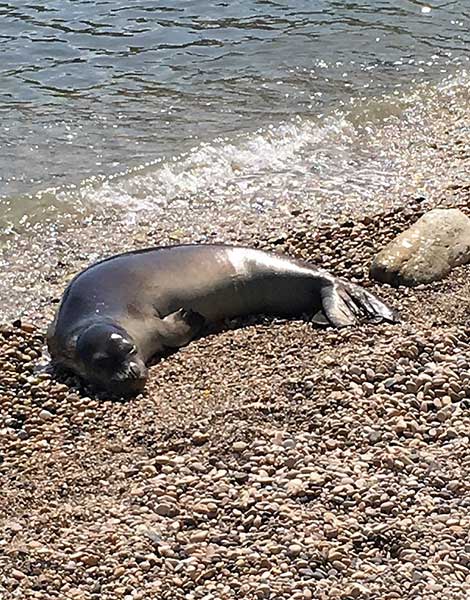
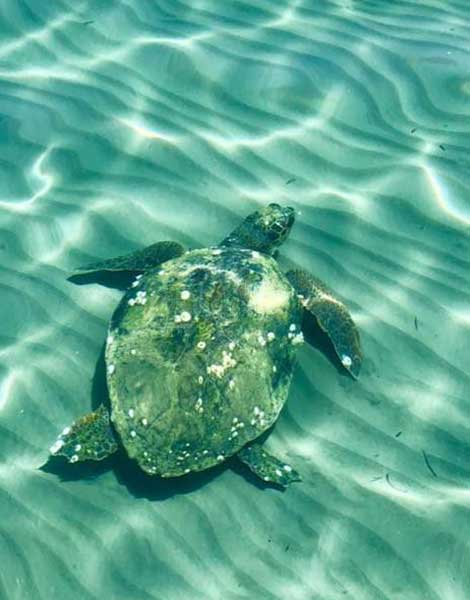
MARINE LIFE
Besides shipwrecks and antiquities, Greek waters are also home to a large variety of sea life. Thanks to the efforts of the authorities and local conservation groups in recent years, the marine environment is becoming cleaner and the ecosystem healthier. As such, sightings are becoming increasingly common, and may include seals, loggerhead sea turtles (Caretta caretta) and dolphins, especially in the months of April and May when sea temperatures are gradually rising.
Other possible sightings between April and September/October include seahorses, blue sharks and basking sharks, known in Greece as the “pilgrim shark.” While rare, the plankton-eating basking shark – the second-largest living shark and fish after the whale shark – are passing visitors in Greek waters during the summer months.

WHEN TO DIVE
Greece and the Greek islands are blessed by hot, dry summers with sea temperatures from June through September ranging from 22-26 degrees C. Temperatures in the shoulder seasons of spring and fall rarely dip below 14 degrees and in the wintertime around 8 or 9 degrees. As such, scuba diving in Greece can be enjoyed more-or-less year round, depending on what you’re used to.
If you have your own equipment, it is recommended to bring a 3/5 mm wetsuit in the summer, and a 5/7 mm wetsuit or semi-dry suit in the winter months.
Visibility in the seas around Greece is usually excellent and, in the calm summer months, offer beginners and novice divers with the ideal conditions to gain more experience and try different dives. The Professional Association of Diving Instructors (PADI) – the world’s largest scuba diver training organization – offers its Open Water Diver course at dozens of dive centers across Greece (c. 170 EUR). The course usually takes between 4 and 7 days to complete, depending on the weather and conditions, so could easily be combined with a summer holiday.

TOP DESTINATIONS [+ 1]
Our list of “Top 10” destinations is by no means exhaustive. It includes a mix of sites for varying levels of experience and, if you stay to the end, there is a cheeky bonus destination for the purists (no air cylinders required).
Right, folks. Final buddy check: “B.W.R.A.F” (BCD/buoyancy, weight, releases, air and final check). All okay?
Let’s go!
1. SANTORINI – VOLCANIC SEA CAVES AND LAVA FORMATIONS
The volcanic island of Santorini in the southern Cyclades, a hugely popular (and massively overdeveloped) tourist haven in the summer months, offers plenty of exciting options for scuba diving enthusiasts. Volcanic eruptions over the millennia have created a maze of underwater lava formations and sea caves teeming with marine life, making the seabed a fascinating place to explore.
One of the most popular dive spots is the small uninhabited island of Nea Kameni, located within the flooded Santorini caldera, formed by the infamous Minoan eruption of c. 1600 BC – one of the largest volcanic events in human history. In Taxiarchis Bay lies the wreck of the “Santa Maria,” a 34 meter-long passenger vessel that sank in 1975. Sitting upright in 18 meters of water, the “Santa Maria” is the ideal wreck dive for beginner through advanced level divers.
In addition to Nea Kameni, its neighbouring sister island Palea Kameni offers some great options for drop-offs and wall dives. The island’s name means “Old Burnt,” and was formed by large deposits of pumice and dacite. Here, you can explore the cliffs of the caldera and come face-to-face with some spectacular marine life, inlcuding seahorses, octopuses and squid. The otherworldly-looking lava formations are home to colorful sponges, schools of fish and the occasional moray eel lurking in the shadows. The area is also home to a protected reef.
2. CHIOS – DRAMATIC WALL DIVES
Lying in the North Aegean just 7 kilometers from the west coast of Turkey, Chios is often cited as one of the best diving destinations in the Mediterranean. Its standout feature would have to be the breathtaking underwater caves, suitable for more advanced divers, but the island boasts shipwrecks, colorful reefs, and some spectacular sea walls for divers of all levels.

Thanks to its location, larger marine life migrate past Chios depending on the season. Aside from the vibrant wrasses, perches and tunnies, you may catch sight of a school of fast-moving tuna flashing by, or even the odd swordfish. In the spring and summer months, you may be lucky enough to encounter sea turtles swimming along the shallow reef areas and, in deeper water, even a sperm whale idling past!
3. NAXOS – IDEAL FOR BEGINNERS
Naxos is ideal for beginners, with plenty of options for shallow dives in gin-clear waters (+ 30 meters visibility). The sea is calm in this particular part of the Cyclades and without fast moving currents, especially in the long summer months, making it a safe place for inexperienced divers to hone their skills.
Dives take place from Agios Prokopios, close to an impressive shallow water reef that runs between Naxos and neighboring Paros, ideal for snorkelling. It is also the location of the wreck of “Marianna,” a Dutch-built cargo ship that crash into the reef and sank in 1981 (all the crew were rescued by a passing ship, the “Panagia Mirtidiotissa”). Lying at a depth of 23 meters, the “Marianna” is a good option for both beginner and intermediate level divers looking to gain experience of wreck diving. The 91 meter-long wreck has become an artificial reef, home to thousands of fish and all kinds of marine creatures.
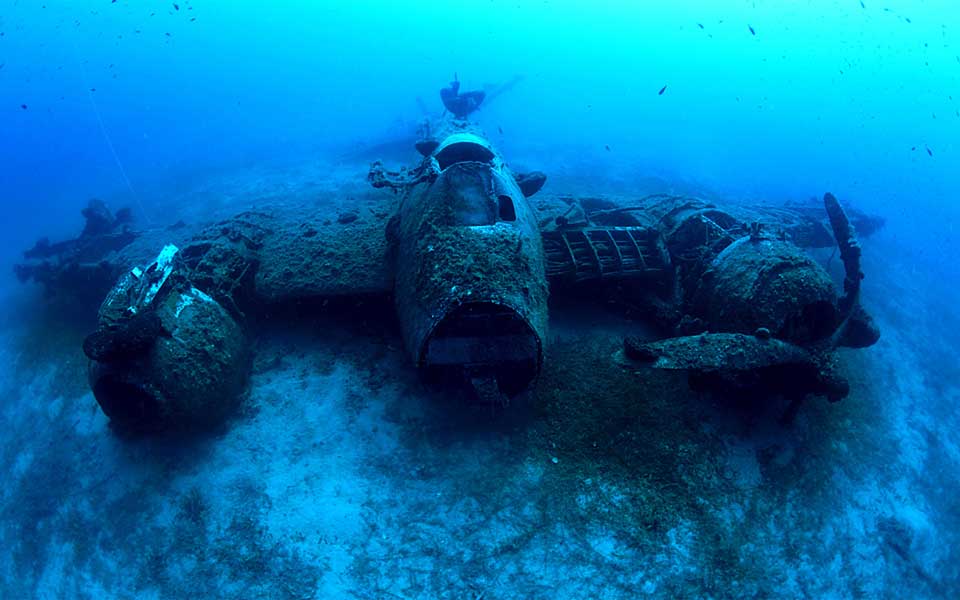
For more experienced divers looking to see something a bit out of the ordinary, Naxos also boasts the famous wreck of a World War II RAF Beaufighter, a British long-range heavy fighter shot down near the island in 1943. The two-man crew managed to bail out and were successfully rescued by local fishermen. Lying flat on seabed at a depth of 34 meters, appearing as though the pilot had made the perfect belly landing, the plane wreck is still in good condition, with only the nose compartment and part of the tail fin missing.
An extraordinary dive, especially for those who love to combine diving with plane spotting!
4. CRETE – THE PERFECT ALL-ROUNDER
Crete has it all; a wonderful year-round holiday destination, with beaches, mountains, beautiful towns and villages, and archaeological sites galore. It is also home to some spectacular diving, from caves, reefs, wrecks, and even sunken Minoan cities! There are dozens of sites to choose from, but aficionados will point to the south coast for fewer crowds, clearer waters, and exciting walls and drop-offs.
If you find yourself near Chania on the northwest coast, and you have the necessary experience, Elephant’s Cave is an absolute must visit. This partially filled underwater cave lies in the Drepano area of Akrotiri, and is home to some striking formations of red and white stalagmites and stalactites, and various sea life.
Deeper inside the cave, more experienced divers will come across the fossilized remains of extinct elephants, megafauna that once inhabited the island at the end of the last Ice Age. Vertebra, teeth and even a tusk can be found on the floor of the cave, and the fossilized remains of other animals are also visible. If you are extremely lucky, you may even see a curious (and very rare) monk seal venturing into the cave to say “hello.”
The area around Chania in general boasts some spectacular stone arches and shallow water reefs, ideal for beginners to explore.
If you are interested in marine life, then head to Schinaria (or Skinaria) on the north coast, near Rethymno. The seabed here hosts a variety of morays, blackfish, octopus and other marine species hidden among the rocks and Poseidon sea grass.
Further east, between Agios Nikolaos and Elounda (the site of a sunken Minoan city), is a shallow reef and favorite haunt of loggerhead sea turtles (Caretta caretta). Needless to say, archaeology is everywhere here, from World War II aircraft wrecks (including an upside down German Messerchmitt 109) to ceramic vases dating all the way back to the Neolithic.
In sum, there is something for everyone in Crete.
5. ALONNISOS – DIVING ON THE “PARTHENON OF SHIPWRECKS”
The Sporades islands are a great choice for the discerning traveler. Made up of 24 islands in the northwest Aegean, they get slightly less attention than the bustling islands of the Cyclades, Crete, Rhodes, et al. With fewer crowds, they certainly have a more relaxed feel.
The islands are home to some great diving, too, and, if you are travelling with non-divers, there are plenty of options for snorkelling, especially around Alonnisos and Skyros.
The area around Alonnisos is the largest natural marine park in the Mediterranean, spanning around 2,260 square kilometers. Home to the elusive Mediterranean monk seal (Monachus monachus), the National Marine Park of Alonnisos and Northern Sporades is protected from over-fishing and development, making it one of the best-preserved ecosystems in the Mediterranean. The area boasts plenty of underwater caves, where you can spot all kinds of marine life.
For history buffs, near the tiny island of Peristera just south of Alonnisos lies one of the most important ancient shipwrecks ever found in Greek waters. The gigantic 5th century BC wreck, with its cargo of 4,000 mostly intact amphorae (ceramic storage jars), lies in 30 meters, making it a spectacular dive for intermediate level divers.
Discovered in 1985, the wreck, dubbed the “Parthenon of Shipwrecks,” covers an area of 25 meters by 12 meters, indicating the shape of the ship’s hull (- the ship was around 30 meters in length), and is thought to have sunk sometime around 425 BC.
This remarkable site is in the process of being developed into an underwater museum by the marine park authorities and the Greek Ministry of Culture and Sports, and will soon open to the diving public for guided tours.
6. LESVOS – OFF THE BEATEN PATH
Sitting in the northern Aegean sea next to Turkey, the large island of Lesvos is relatively unexplored in terms of dive tourism. For those wanting to get off the beaten path, there is plenty of untapped potential here.
Like Chios to the south, Lesvos boasts some spectacular sea walls and reefs, suitable for beginner and more advanced levels divers, and there is an abundance of marine life. With more than 30 diving sites to choose from, inlcuding wrecks, reefs and caves, there is something for everyone.
On the northwest coast, near the village of Petra, Mirmigi Reef is fast becoming a popular dive site for those in the know. Blessed with otherworldly volcanic formations and seabed topography, the reef teems with colorful fish and marine life. Its excellent visibility and absence of strong currents make it an ideal dive for beginners, but more advanced divers can explore deeper. The reef starts at roughly 5 meters and progresses down to 36 meters.
7. MYKONOS – A WRECK DIVERS PARADISE
While Mykonos is famous around the world for its vibrant party scene, the crystal clear waters surrounding the Cycladic island are full of interesting sites to explore, including two shipwrecks.
Located off Lia Beach on the southeast coast is the wreck of the “Anna II,” a 62 meter-long cargo ship that sank in July 1995. Lying at a depth of 25 meters, the wreck is still in excellent condition and parts of it are accessible for limited penetration diving (within the “light zone”). The area around the wreck is equally interesting, with a colorful reef and colonies of sea sponges attracting an incredible array of marine life.
The second wreck, the “Peloponnisos,” can be found off the northeast coast, and is better suited for more experienced divers due its depth and challenging weather conditions (strong meltemi winds in the summer months can make the waters choppy and affect visibility). Referred to as the “Electric,” the wreck is a 64 meter-long passenger-cargo ship, built in 1862-1863 by the Tod & McGregor shipyard in Glasgow, Scotland, that sank in July 1926 (another summertime sinking). Split in two pieces, the wreck site is now a spectacular artificial reef.
Another popular site on Mykonos is the Tragonisi cavern and cave system – for advanced divers only. Located off the east coast, the tiny rocky islet of Tragonisi offers some impressive submerged caverns to explore, including a number of overhead tunnels and chambers within site of the entrance, festooned with distinct looking yellow sea anemones. A protected nature reserve, the area is also a natural haven for the rare and endangered monk seal. For those with the necessary experience, dives at the Seal Cave, where you may, if extremely lucky, come face-to-face with a seal, can be booked by prior appointment.
8. ZAKYNTHOS – A SEA TURTLE HAVEN
On the western side of Greece, the Ionian islands are must for nature lovers. Zakynthos (sometimes known as Zante in English and Italian), the third largest island in the archipelago, is home to a marine park, established in 1999 to safeguard nesting loggerhead turtles and migratory birds calling at the Strofades islets. Critically endangered loggerheads nest along the beaches of Marathonisi, a tiny uninhabited island off Zakynthos from May to August. If you are lucky, you may spot one swimming nearby.

It should be noted that the Ionian Sea is noticeably cooler than the Aegean but the visibility is crystal clear. There are a number of submerged cave sites around the island’s southwestern Keri promontory, accessible by boat. A popular boat dive at Lakka has an undersea arch at a depth of 12 meters and covered in colorful sponges, perfect for beginner and intermediate divers looking to gain more open water experience. Here, you can free-fall down the rocky escarpment and encounter all kinds of fish, inlcuding blennies, wrasse, sea bream and cheeky little parrot fish darting among the anemones.
For more advanced divers with experience in overhead environments, the butterfly-shaped entrance to the Cave Tunnel is widely regarded as one of the most beautiful diving spots on the island. The cave interior is home to countless tiny shrimp, tucked away among the rooks and crevices.
9. CORFU – DIVING IN TURQUOISE WATER
The largest of the Ionian islands, Corfu offers underwater caves, wall dives, and fun swim-throughs, as well as shallow limestone reefs covered in sea life. The island’s northwest coast is fast becoming a top choice for scuba diving in Greece. The area of Paleokastritsa in particular is known for its clear, turquoise waters and beautiful beaches, the perfect place for beginners to embark on certification courses, but there are plenty of options for more experienced divers.

One of the most popular and easily accessible dive sites on the island, located a mere 100 meters off the northwest coast, is called the Monastery. Suitable for divers of all levels, the site is renowned for its vibrant colors and amazing caves.
Even more spectacular is the Hole of Ha, a dive site that makes Corfu a cavern diving mecca. This incredible site is an easy cavern dive that goes inside a mountain, where you will see stalactites and fossilized conch shells. It has no roof, which means when you look upwards, you can see the trees that surround the hole in the mountain.
10. KEA – SOMETHING FOR THE TEKKIES
Returning to the Cyclades, the little island of Kea boasts one of the most famous shipwrecks in the world – the “HMHS Britannic,” sister ship of the doomed “RMS Titanic” that sank in 1912.
The gigantic ocean liner, the third vessel of the White Star Line’s Olympic class of steamships, was requisitioned as a hospital ship for service in World War I. On the morning of November 21, 1916, the ship, carrying 1,065 people on board, mostly sick and wounded Allied soldiers from the Middle Eastern theatre and attending medical staff, struck a German mine near Kea and sank with the loss of 30 lives.
It is important to note that the “HMHS Britannic,” the largest passenger shipwreck in the world (it was slightly bigger than the Titanic), is a scheduled war grave. As such, it is protected by laws enforced by the Hellenic Coast Guard and the country’s Ministry of Culture. At 122 meters, the depth of the wreck is far beyond the limits of safe scuba diving (the PADI Advanced Open Water certificate, for example, qualifies divers to go to 30 meters). As such, it is the exclusive preserve of extremely well qualified and experienced technical divers with all the necessary equipment (open-circuit trimix), but has nonetheless claimed the lives of two veteran divers in the past 12 years.
If deepwater technical diving is not your thing, there are plenty of other options on Kea, in the serene Ksyla Bay, for example, where you can spot all kinds of colorful fish and other marine life.
Also, the wreck of the 19th century paddle steamer “Patris” (meaning “Homeland”) is one of the world’s most spectacular shipwrecks, preserved in excellent condition and located within safe recreational diving limits. Sunken off the island’s southwest coast in late February 1868, the ship was carrying around 500 passengers from Piraeus to the island of Syros when it slammed into the shallow reef at Koundouros Bay. All were rescued, but the steamer split in two. One section lies in 18 meters of water while the other, located nearby, is deeper, at 35 meters.
“THIS ONE GOES TO 11 …” SOMETHING FOR THE PURISTS – FREEDIVING IN AMORGOS
No destination list for diving in Greece would be complete without something for freediving – the purest form of diving. After all, ditching the heavy scuba gear allows for greater mobility (albeit for a limited time), less noise (open circuit regulators are quite loud), and an even greater sense of mind-body connection to the sea. What’s more, freediving (or skin diving) is low cost, requiring only a mask, snorkel and fins (and wetsuit depending on sea temperature).
The art of freediving in the Mediterranean goes back to at least the Neolithic, when coastal foragers collected shellfish, crustaceans and other food from the seabed. In ancient Greece, both Homer (8th century BC) and Plato (late 5th-4th century) infer the harvesting of sea sponges, and Thucydides even mentions the use of military divers to evade enemy blockades in the Peloponnesian War (431-404 BC).
Today, freediving is a hugely popular past-time, branched into multiple competitive and non-competitive activities, including snorkeling, spearfishing, and a range of apnea (breath-hold) disciplines.
In Greece, the Cycladic island of Amorgos is THE location for freediving, boasting crystal clear waters, scenic bays, and accessible sites for freedivers of all levels. The island was featured in Luc Beeson’s legendary film Le Grand Bleu, the fictionalized story of the friendship and rivalry between real-life freedivers Jacques Mayol (1927-2001) and Enzo Maiorca (1931-2017), making it a popular draw for people wanting to experience the ultimate freedom.
A number of dive centers on the island offer freediving courses. Ripe with Cycladic charm, Aegiali Bay in the northern part of the island is the perfect place to start; an easy shore dive featuring a shallow water reef and a wide range of colorful marine life. Boat trips to nearby Nikouria island offers more options, while the Deep Blue Wall at the western tip features a stunning cavern at 25 meters.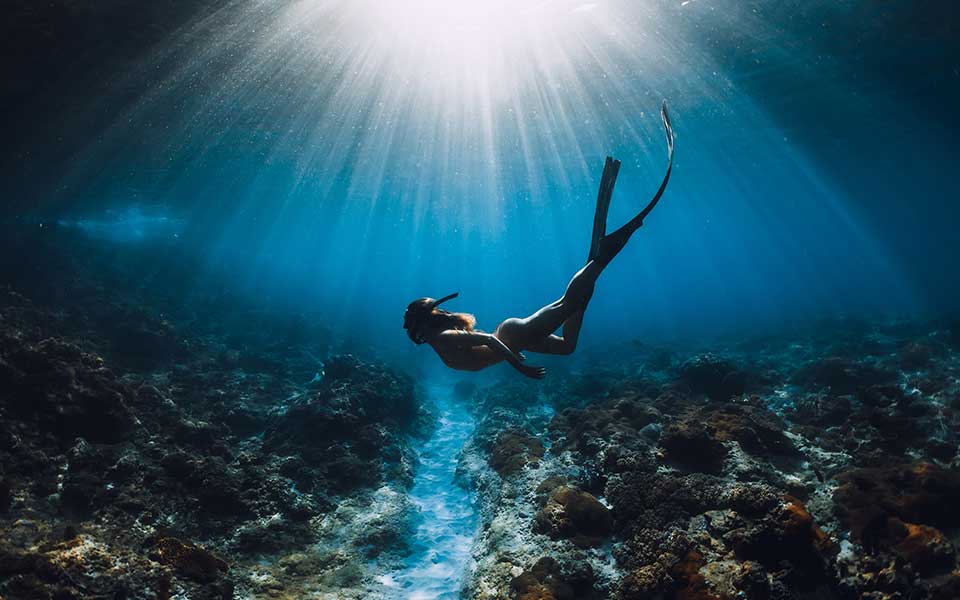
ONE FINAL THOUGHT …
While the above list only takes into account islands, it should be noted that there are plenty of options for diving along the extensive coastline of the Greek mainland, especially in the Peloponnese and Attica.
In the waters near Athens, there are numerous reef diving spots, offering coral-encrusted walls, rocks and caves teeming with Mediterranean reef life. The seabed is also littered with antiquities, evidence of the region’s rich maritime history.
Likewise the Peloponnese, in the country’s south, where wrecks, reefs, and submerged canyons offer a wealth of diving options. The Bay of Navarino, in the southwest, is of particular note. Here, a combined allied fleet from Great Britain, France and Russia defeated the Ottoman fleet in 1827, a battle that would help secure Greek independence. Three Ottoman ships can be visited in the bay, as well as the oil tanker “Irene Serenade,” which sank in 1980. The tanker’s keel lies at 47 meters but its deck is only half that depth, making it accessible to beginner wreck divers. At 282 meters in length, it is the world’s second longest visitable shipwreck.
source: https://www.greece-is.com/










